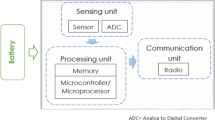Abstract
Cluster based communication protocols for sensor networks are useful if the cluster formation is energy efficient. Centralised cluster formation can be applied when the sensor network is hybrid, fully wireless but less mobile, or fully wireless with a known sensor location. In a cluster based communication protocol, sensors within a cluster are expected to be communicating with a cluster head only. The cluster heads summarise and process sensor data from the clusters and maintain the link with the base station. The clustering is driven by the minimisation of energy for all the sensors. The paper extends the energy equations to hybrid and wireless sensor networks. Recent developments in generic clustering methods as well as customized optimisation methods based on Genetic Algorithms are used for centralised cluster formation. The paper compares the simulation results of 4 clustering algorithms.
Preview
Unable to display preview. Download preview PDF.
Similar content being viewed by others
Author information
Authors and Affiliations
Editor information
Rights and permissions
About this chapter
Cite this chapter
N. Halgamuge, M., M. Guru, S., Jennings, A. Centralised Strategies for Cluster Formation in Sensor Networks. In: K. Halgamuge, S., Wang, L. (eds) Classification and Clustering for Knowledge Discovery. Studies in Computational Intelligence, vol 4. Springer, Berlin, Heidelberg. https://doi.org/10.1007/11011620_20
Download citation
DOI: https://doi.org/10.1007/11011620_20
Published:
Publisher Name: Springer, Berlin, Heidelberg
Print ISBN: 978-3-540-26073-8
Online ISBN: 978-3-540-32404-1
eBook Packages: EngineeringEngineering (R0)




